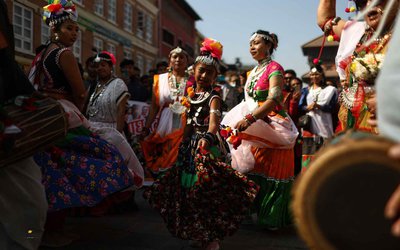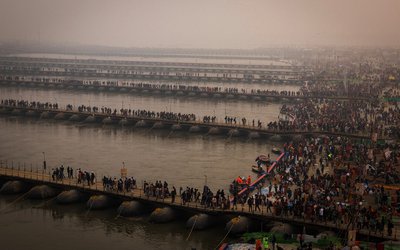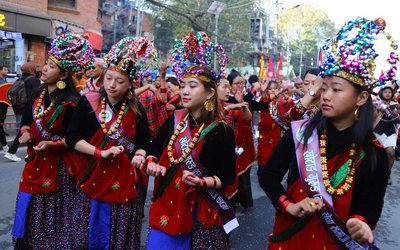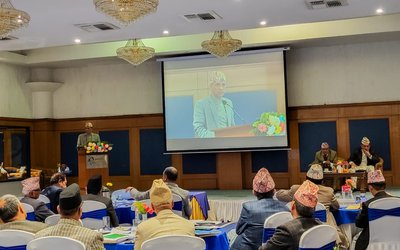
Today is Haribodhini Ekadashi. This is one of the important festivals of Nepal. This occasion dedicated to Lord Vishnu has equal importance like that of Shivaratri to the devotees of Lord Shiva.
Tulsi Vivah 2019: Date, puja timings and significance
Tulsi Vivah falls right after the November Ekadashi date and it marks the end of the monsoon and the beginning of the wedding season. This year, Tulsi Vivah 2019 falls on November 9. It is observed by married women in India for blessings.
Tulsi Vivah falls right after the November Ekadashi date and it marks the end of the monsoon and the beginning of the wedding season.
Tulsi Vivah 2019, one of the most auspicious days in the Hindu calendar, is being celebrated on November 9. This celebration commemorates the marriage of Lord Vishnu to a Tulsi plant, which is also said to be an incarnation of Goddess Lakshmi. The marriage has to be celebrated Day 12 of the lunar cycle or Dwadashi during the Shukla Paksha in the month of Karthik -- right after Ekadashi (Day 11 of the lunar cycle) in November. The ceremony has to be celebrated between Prabodhini Ekadashi and Kartik Poornima.
Married women celebrate Tulsi Vivah for marital bliss while unmarried women celebrate it to get good husbands.
What is the legend behind Tulsi Vivah?
There is a story of Lord Vishnu which gave rise to the celebration of Tulsi Vivah. A demon king named Jalandhar was famous for his evil acts but the secret of his great success was his wife Brinda’s virtuous character. Brinda was also a devotee of Lord Vishnu and prayed constantly for her huband’s well-being. To stop Jalandhar’s evil acts and power, Vishnu took the form of Jalandhar and took away Brinda’s celibacy.
Soon after, Jalandhar lost in a fight and died. When Brinda got to know of what Vishnu did, she cursed him to turn into the Shaligram stone and then immolated herself on her husband Jalandhar’s pyre. Lord Vishnu turned Brinda’s soul into a Tulsi plant with the promise to marry her.
The Tulsi plant is said to be a form of Goddess Lakshmi, and Brinda is one of her incarnations. In the next birth, on the day of Prabodhini Ekadashi, Lord Vishnu in the form of Shaligram married Tulsi. Thus, the Tulsi Vivah ritual includes the marriage of a Shaligram stone to a Tulsi plant.
How is Tulsi Vivah celebrated?
Tulsi Vivah can be celebrated either in temples or at home. Usually, a fast or Tulsi Vivah vrat is kept till the evening when the rituals are started.
The ceremony begins with bathing a Tulsi plant and a Vishnu idol and decorating both with garlands and flowers. The Tulsi plant is decorated like a bride with a red sari, jewellery and bindi. The Vishnu idol is dressed in dhoti. A thread is then tied to link the couple.
The ceremony ends with people showering vermilion and rice on the couple. After that, Prasad is distributed among the devotees.
This day is believed to be the one when Lord Vishnu wakes up from his slumber and presides over the religious rites across the universe. On this occasion, the Seshnarayan temple, along with the other three of the Char Narayan temples are crowded with the devotees to pay their homage to the Lord.
Legend has him guarding the gates of the King Bali in Pataal (the land under earth according to the Hindu literature) as was his turn. It is believed that the folks in heaven (gods and saints) were suspicious of Bali’s generosity and had him deported, literally, down to Pataal, however, the three supreme gods impressed with his generosity and selfless acts, agreed to be his gatekeeper. The holy Trinity of Brahma, Vishnu and Shiva took turns, each diving three months in between shifts and according to the holy scriptures, it was Vishnu’s turn.
The major festive celebration on this day happens in the city of Kathmandu itself. Some of the most important shrines of Lord Vishnu are situated in the valley since the time immemorial as the ancient rulers of the city did all they could to make the city prosperous, like designing the city in a way that the four cardinal points would have the shrines of Lord Vishnu guarding the valley. In the past, devotees used to visit all the four temples on this day and that too, on foot, however, with the fast growing modernization and work load, people would be lucky if they could manage to visit any one of them.
However, in the past, despite of where they began their holy quest, they always tend to finish it at Sesh Narayan temple as Sesh also meant ‘final’. Those who could not visit all the four temples situated at the four cardinal points of the valley visited the Char Narayan temple in Mangal Bazaar. Also, the Nepali month of Baishak (April- May) is considered auspicious to visit Lord Vishnu‘s shrine in Budanilkantha.
Credit: India Today and Boss Nepal
- Global Library Summit 2025: A Landmark Event in Library Diplomacy
- Feb 11, 2025
- Green Economy A Priority
- Feb 11, 2025
- Weather Forecast: Partly To Generally Cloudy In Hilly Areas of Sudur Paschim, Karnali and Gandaki Provinces
- Feb 11, 2025
- NEA Declares Dhanushadham A Electricity Theft-Free Municipality
- Feb 10, 2025
- Weather Forecast: Partly To Generally Cloudy In Sudur Paschim, Karnali and Gandaki Provinces
- Feb 10, 2025
















